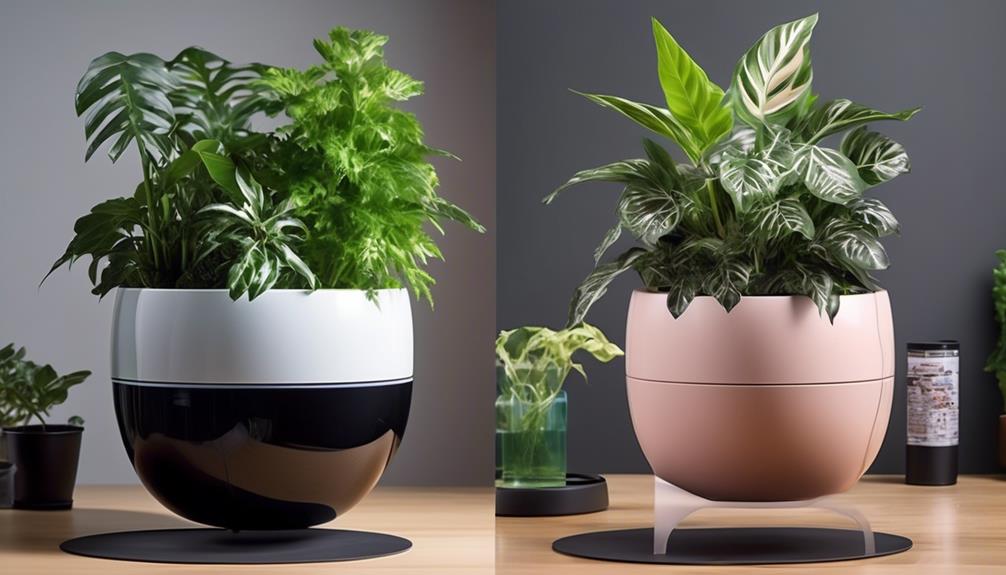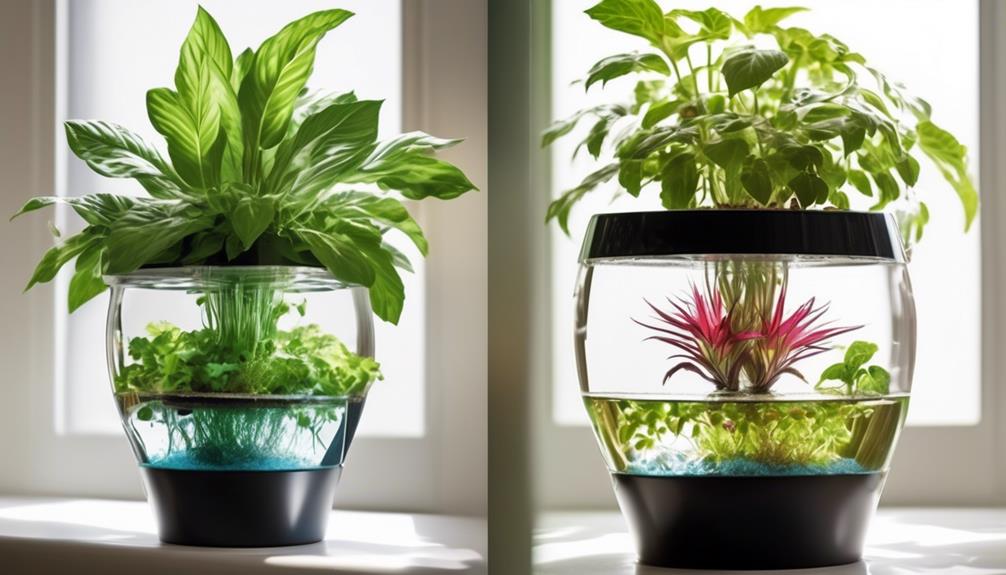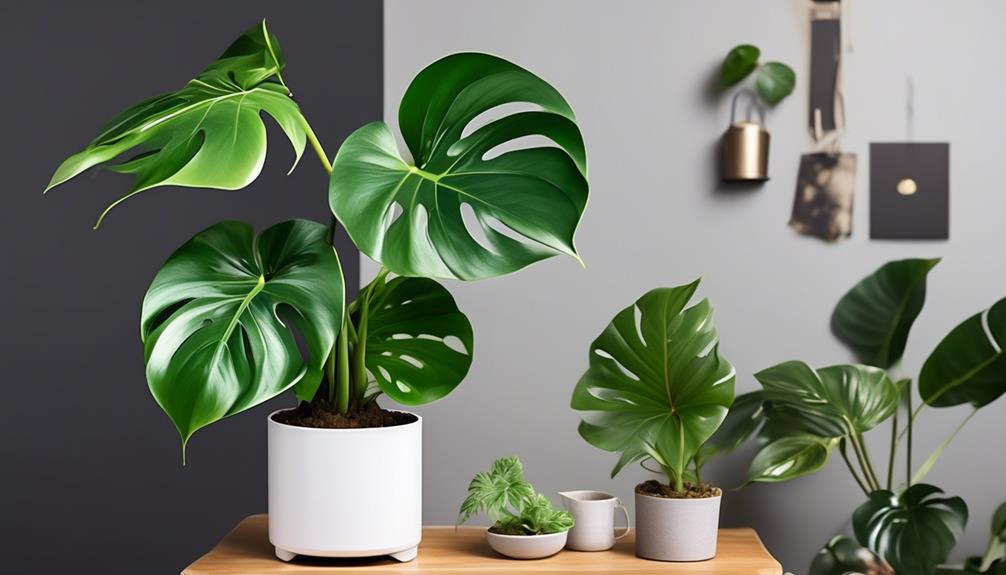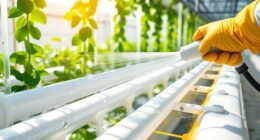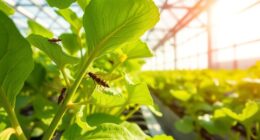Are you familiar with the feeling that your plants are always in need of attention, constantly craving some hydration?
Well, what if I told you there's a way to give them a constant supply of water without you having to hover over them with a watering can every day?
Homemade self-watering plant pots might just be the solution you've been searching for. These innovative containers can help keep your plants hydrated while giving you more time to sit back and enjoy their lush greenery.
But how exactly do they work, and how can you make one yourself?
Let's explore the benefits, materials needed, assembly instructions, maintenance tips, and creative customization ideas for these game-changing plant pots.
Key Takeaways
- Self-watering plant pots provide consistent moisture for plants.
- They prevent overwatering or underwatering.
- They support proper growth, photosynthesis, and nutrient uptake.
- They contribute to cost savings and sustainability.
Benefits of Self-Watering Plant Pots
Self-watering plant pots offer the advantage of providing a consistent moisture level for plants without the need for frequent manual watering. This technology enhances watering efficiency by delivering water directly to the plant's roots as needed, preventing overwatering or underwatering. Maintaining optimal moisture levels is crucial for plant health, as it supports proper growth, photosynthesis, and nutrient uptake. The self-watering feature helps create an ideal environment for plants to thrive, promoting their overall well-being.
In addition to promoting plant health, self-watering plant pots contribute to cost savings and sustainability. By ensuring that plants receive just the right amount of water, these pots reduce water wastage and minimize the need for frequent refills. This not only conserves water but also leads to cost savings for individuals and promotes sustainable water usage.
Furthermore, the consistent moisture provided by self-watering pots can lead to healthier, more robust plants, reducing the likelihood of plant loss and the associated costs of replacing them. Overall, the benefits of self-watering plant pots align with the principles of efficiency, cost-effectiveness, and environmental sustainability.
Materials Needed for DIY Project

Ensuring proper moisture levels for plant health, we will need specific materials to construct a DIY self-watering plant pot. The success of a self-watering system lies in the choice of materials, as they directly impact the efficiency of the watering system and the overall plant care. Below is a table detailing the essential materials for constructing a homemade self-watering plant pot:
| Component | Purpose | Recommended Materials |
|---|---|---|
| Water Reservoir | Stores water for the self-watering system | Plastic container or |
| reservoir pot | ||
| Wicking Material | Draws water from reservoir to soil | Cotton rope, felt or |
| capillary mat | ||
| Growing Medium | Holds the plant and allows water absorption | Potting mix, peat moss, |
| or coco coir | ||
| Planter Pot | Holds the growing medium and supports plant | Plastic or ceramic pot |
| with drainage hole | ||
| Water Level Indicator | Monitors water level in the reservoir | Clear plastic tubing or |
| a simple float |
Step-by-Step Assembly Instructions
After gathering all the necessary materials, we can begin assembling the self-watering plant pot following these step-by-step instructions.
- Step 1: Start by drilling a small hole in the center of the plant pot's base to accommodate the wick.
- Step 2: Thread the wick through the hole, leaving a few inches protruding from the bottom, and place the pot inside the reservoir.
- Step 3: Fill the base of the reservoir with water, ensuring the wick is submerged, and place the soil-filled pot on top.
- Step 4: Add water to the reservoir as needed, keeping an eye on the water level and refilling when it becomes low.
- Step 5: Check the plant's moisture regularly, adjusting the water level to prevent overwatering or underwatering.
Troubleshooting common issues may include adjusting the wick length or increasing the size of the reservoir for larger plants. Cost-effective alternatives can involve using recycled containers as reservoirs or repurposing materials for the wick.
Tips for Maintaining Self-Watering Pots
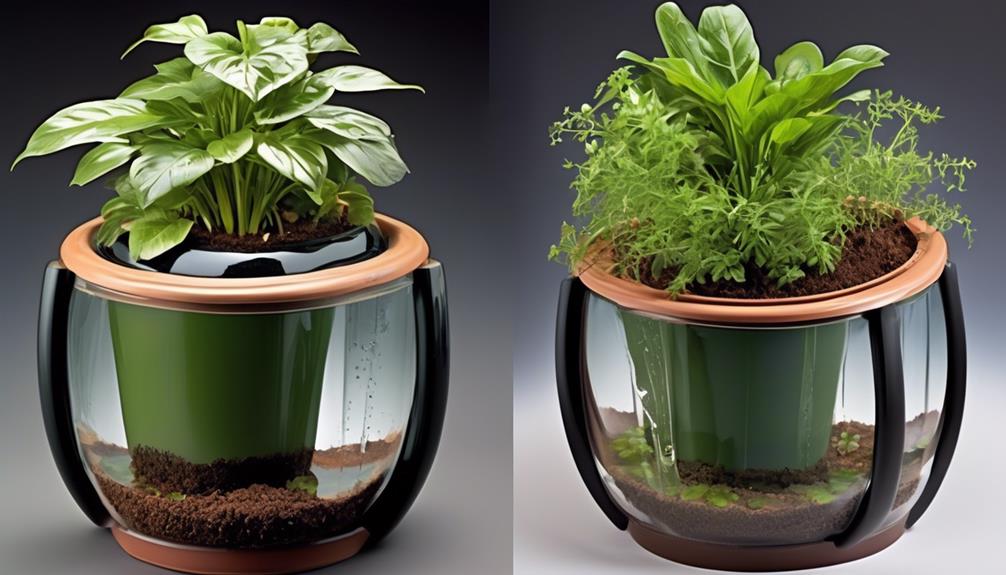
With the self-watering plant pot successfully assembled, maintaining its optimal functionality requires careful attention to several key tips.
First, monitor the watering frequency by checking the water level indicator or observing the soil moisture. Adjust the frequency based on the specific needs of the plant and the environmental conditions. It's essential to strike a balance to avoid overwatering or underwatering, both of which can negatively impact plant growth.
Additionally, regularly inspect the soil to ensure it remains loose and aerated, promoting healthy root development. Cleaning the pot periodically is crucial to prevent clogs and algae growth, which can interfere with the self-watering system.
Furthermore, prune the plants as needed to maintain their size and prevent overcrowding within the pot. Lastly, keep an eye out for any signs of nutrient deficiency or pest infestation, addressing these issues promptly to support optimal plant growth.
Following these maintenance tips will help ensure that your self-watering pots continue to provide an ideal growing environment for your plants.
Creative Ideas for Customization
To enhance the functionality and aesthetic appeal of self-watering plant pots, consider incorporating innovative design elements that prioritize both form and function. Customization ideas and decorative options can elevate the visual appeal and practicality of your self-watering pots. Here are some creative ideas for customization:
- Personalized Labels: Use customizable labels to add a personal touch to your plant pots. This can help in identifying the type of plant, watering schedule, and any specific care instructions, making it easier for others to help care for the plants.
- Colorful Designs: Choose vibrant and eye-catching colors for your pots to add visual interest to your indoor or outdoor space. Consider using eco-friendly paints and finishes to ensure the safety of the plants.
- Integrated Lighting: Incorporate LED lighting into the design of your self-watering pots for added ambiance and to showcase your plants, especially in low-light areas.
- Texture and Patterns: Experiment with different textures and patterns to create unique and visually appealing plant pots. This can involve using materials like mosaic tiles, textured paints, or decoupage techniques.
- Customized Sizes and Shapes: Explore unconventional shapes and sizes for your self-watering pots to create a striking visual display and accommodate various plant types.
Frequently Asked Questions
How Often Do I Need to Refill the Water Reservoir in a Self-Watering Plant Pot?
We refill the water reservoir in self-watering plant pots based on the plant's water needs. Optimal plants for this technology are those that require consistent soil moisture.
The frequency of refilling depends on factors such as plant type, pot size, and environmental conditions. It's important to consider the soil requirements of the plants and adjust the refilling frequency accordingly to maintain an adequate moisture level for healthy growth.
Can I Use Self-Watering Plant Pots for All Types of Plants, or Are There Specific Ones That Work Best?
We've found that self-watering plant pots can work well for a variety of plants, yet some are better suited due to their water needs. It's essential to consider the plant's natural habitat and water requirements.
Best plants for self-watering pots include herbs, vegetables, and small houseplants. Selecting the right soil type and regular maintenance of the water reservoir are crucial for these pots.
It's important to choose plants that thrive in consistently moist soil.
Are There Any Potential Drawbacks or Limitations to Using Self-Watering Plant Pots?
Potential drawbacks and limitations of self-watering plant pots may include maintenance requirements and limitations on soil type.
While these pots can reduce watering frequency, they may require more attention to avoid overwatering.
Additionally, certain soil types, such as heavy clay, may not work as effectively with self-watering pots.
However, with proper maintenance and suitable soil, these pots can greatly simplify plant care.
Can I Use Regular Potting Soil in a Self-Watering Plant Pot, or Do I Need a Specific Type of Soil?
We can use regular potting soil in self-watering plant pots.
It's essential to choose a well-draining potting mix to prevent waterlogging, which can lead to root rot.
The soil should also retain moisture to support the self-watering system.
Look for potting mixes labeled for container gardening or specifically designed for self-watering pots, as they often contain a blend of organic materials like peat moss, coconut coir, and perlite for optimal water retention and drainage.
Are There Any Additional Maintenance Tasks Required for Self-Watering Plant Pots, Aside From Refilling the Water Reservoir?
Aside from refilling the water reservoir, there are additional maintenance tasks required for self-watering plant pots.
These pots offer additional benefits such as reducing watering frequency and promoting healthier plant growth.
However, potential problems include algae growth and the need to periodically clean the reservoir to prevent mold and bacterial growth.
Regular maintenance also involves checking the water level, adjusting the soil moisture, and occasional cleaning to ensure optimal plant health.
Is It Possible to Replicate the Self Watering Feature of Lechuza Plant Pots at Home?
Replicating the self watering feature of Lechuza plant pots at home is possible with a little ingenuity. By using materials such as plastic bottles or self watering spikes, you can create a similar system to keep your plants hydrated. However, nothing beats the convenience and efficiency of authentic Lechuza self watering pots.
Conclusion
In conclusion, homemade self-watering plant pots are a cost-effective and efficient way to keep your plants healthy and thriving.
Did you know that plants in self-watering pots can last up to 80% longer without needing to be watered compared to traditional pots?
By following the simple DIY instructions and customizing your pots, you can create a beautiful and low-maintenance garden that will bring you joy for years to come.




